Mountains & Minds: Learners and Leaders
Discovery
Goal:
MSU will raise its national and international prominence in research, creativity,
innovation and scholarly achievement, and thereby fortify the university's standing
as one of the nation's leading public research universities.
Objective D.1: Elevate the research excellence and recognition of MSU faculty.
Metric D.1.1: By 2019, MSU will increasingly attract and retain faculty of national and international recognition.
Technical note: Data on retention and hires are available through central databases and are currently reported under the auspices of ADVANCE Project TRACS. Prominence may be indicated using a combination of comparative data from Academic Analytics and self-reported activity in Activity Insight for disciplines not covered by Academic Analytics.
Metric D.1.2: By 2019, national and international recognition of MSU faculty will improve as measured through scholarly and creative accomplishments.
Technical note: Measures include but may not be limited to national awards, peer-reviewed publications, grant awards, invited presentations, journal citations, fellowships, editorial positions, technology transfer activities, visiting appointments, hosting scholarly conferences, membership on governmental policy committees, review panels, museum-level exhibitions, and creative work that engages audiences at leading venues. These data are reported in Academic Analytics and Activity Insight.
Metric D.1.3: By 2019, MSU will improve its rank among Carnegie Classified Research Universities – Very High Research Activity (RU/VH) institutions on four measures: STEM R&D expenditures (current rank 94); Non-STEM R&D expenditures (rank 92); Number of science and engineering research staff (rank 96); and doctoral conferrals (rank 106).
Technical note: The Carnegie classification is determined by four aggregate measures and three per-capita measures of research activity. MSU ranks in the top 50 in each of the three per-capita measures, but in the lowest 20 on the four aggregate measures (because of our relatively small size). STEM is an acronym for Science, Technology, Engineering and Mathematics. These figures are compiled annually by the Carnegie Foundation and available at http://classifications.carnegiefoundation.org/resources/
Objective D.2: Enhance infrastructure in support of research, discovery and creative activities.
Metric D.2.1: By 2019, funding for capital projects from public and private sources will increase in order to provide state-of-the-art laboratory, studio and other space-related resources.
Technical note: Annual capital expenditures by source are available in the accounting system. We have not routinely tracked those in a specific report, but that is possible.
Metric D.2.2: By 2019, MSU will increase grant-sponsored investment in centers, core facilities and resources to expand state-of-the-art tools, expertise and opportunities for research and creative activities.
Technical note: Annual capital expenditures by source are available in the accounting system. We have not routinely tracked those in a specific report, but that is possible.
Objective D.3:Expand the scale, breadth and quality of doctoral education.
Metric D.3.1:The percentage of faculty who advise doctoral students will increase by 2019.
Technical note: These data may be culled from dissertation committee rosters collected by the Graduate School or gathered in a faculty activity reporting system.
Metric D.3.2: The graduate student population will increase 20 percent to approximately 2,350 by 2019, with an emphasis on increasing doctoral student enrollment.
Technical note: Fall 2011 headcount graduate student enrollment was 1965. This same metric appears
in the Access section of this plan. This metric represents headcount enrollment and
is consistent with Objective 2.3.1 in the MUS Strategic plan, which uses FTE enrollment.
See http://mus.edu/data/StratPlan/13_Goal_2_Graduate_Education_2012.pdf.
Metric D.3.3:By 2019, the number of graduate degrees awarded will increase from 548 to 625 per
year. Science, technology, engineering and mathematics (STEM) master’s and doctoral
degrees will increase to 325. All doctoral degrees awarded will increase from 56
to 80 per year.
Technical note: This metric is consistent with the overall and broad STEM definition in Metric 2.3.2 in the MUS Strategic Plan. See http://mus.edu/data/StratPlan/13_Goal_2_Graduate_Education_2012.pdf.
Metric D.3.4: The number and proportion of doctoral students presenting at national and international meetings, publishing in eminent academic outlets, earning high-profile fellowships, securing prizes from national and international competitions and garnering prestigious job placements will increase by 2019.
Technical note: These data are currently available only at the departmental level, so this metric will require a new collection effort.
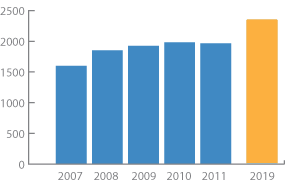
Metric D.3.2:Graduate Student Fall Headcount Enrollment
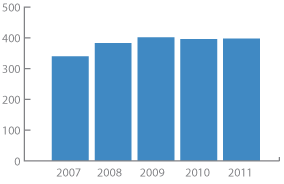
Metric D.3.2:Doctoral Student Fall Headcount Enrollment
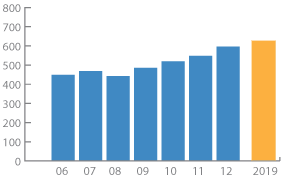
Metric D.3.3:Graduate Degrees Awarded
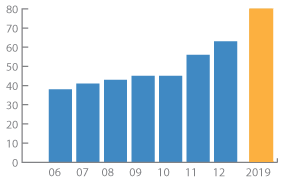
Metric D.3.3:Doctoral Degrees Awarded
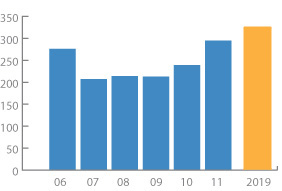
Metric D.3.3:Graduate Degrees in STEM Fields Awarded
